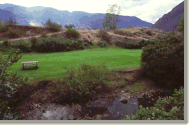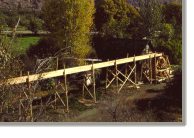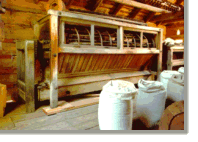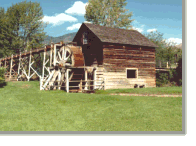

TOUR MAP

INTRODUCTION

CIRCLE GARDENS

APPLE ORCHARD

WHEAT FIELDS

GRIST MILL

EXHIBIT BUILDING

ROOT CELLAR

VISITOR'S CENTRE
 |
 |
| Grist Mill |
 |
How do I work? Since I was not built during the time of electricity I depended on water for power. The water I needed was taken from keremeos Creek. The water travelled along a wooden flume to the water wheel. |
| With the help of gravity, the water falls on the wheel causing it to turn. When the wheel turns it provides a source of power to run the mill. Just thought you might want to know my "water wheel rotates at only 10 revolutions per minute (rpm) or once every 6 seconds. A bucket elevator works well at 40 rpm, a grinder at 300 and the Eureka cleaner at 700 rpm or 12 times a second!"(Grist Mill, 22.) |
 |
| An important aspect of making flour that is often not mentioned is the machinery that takes the wheat and flour to their appropriate machines. |
 |
"Augers and elevators move grain and flour from one machine to the next. This system of automation was developed in 1795 by a great American genius of invention, Oliver Evans. It became the industry standard, represented perfectly in the wooden augers and bucket elevator structures of the Grist Mill."
(Grist Mill, 20.) |
| These augers and elevators are positioned within me to take advantage of my structure. If the mill did not have augers and elevators I would not be able to make flour. |
| In order for wheat to be converted into flour it needs to be cleaned, ground, and sifted. The 'Eureka Smut & Separating Machine' cleans the grain so it will not spoil. The 'Barford & Perkins' machine job was to grind the grain. The 'Hexagon Reel Bolter' machine sifted the flour. |
 |
 |
Barrington Price wanted me to be the best grist mill in the world. Technology in the grist milling industry was improving at a fast rate and my owner made sure that I always had the best. |
In 1881, a new grinder was added to the mill. This grinder called 'New Process' had the ability to grind grain to a smaller size. The James Jones 'New Process' grinder was able to create a better quality of flour because of its 'rolling stone' technology. Researchers believe that I have the only James Jones 'New Process' grinder still in operation in the world! With the new changes I could now produce white flour. Producing flour is what makes a grist mill the happiest!
Wow!
I have really given you a lot of technical information. I wonder if you can remember any of it?
How does the mill receive its power?
What is used to transport grain and flour once inside the mill?
Can you name some of the machines at the Grist Mill?
Can you remember what year was the "New Process" grinder added?
|





